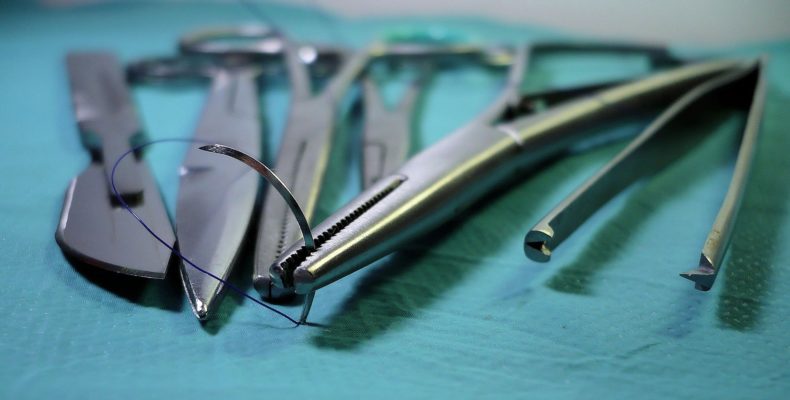
Keeping in line: intraoperative surgical guidance innovation
Surgery is, by its very nature, an invasive procedure. It can be transformative to the quality of life of those suffering from chronic issues such as arthritis or heart disease, but before any improvement comes an inevitable period of healing and recovery.
Many modern surgical techniques aim to reduce the length of time a patient must spend in recovery. Recovery time can be reduced by minimising the damage done during surgery – the fewer cuts a surgeon needs to make, or the smaller those cuts are, then the less healing a patient needs to do to get back on form.
Traditionally, a knee replacement operation requires a large incision of about 6-12 inches. Through that incision a surgeon shapes (‘resects’) the bones of the patient’s joint to remove damaged bone and to receive the metal implant that will form the replacement joint. It is important that the resected bone is the right shape to fit the implant, and so the surgeon uses drill guides or cutting jigs to help make accurate cuts. These guides are often screwed or clamped onto the bone to make sure they cannot move during cutting. No surgeon wants to cut away undamaged bone if it does not need to be removed, or worse, cut through critical soft tissues like arteries and ligaments – drill guides help avoid that.
However smaller cuts mean less space to fit such guides, less room for the surgeon to manoeuvre, and poorer visibility. Minimally invasive surgery can therefore make life trickier for a surgeon, even though it can often have a better outcome for patients.
There are a number of innovative companies working to make surgeons’ lives easier without compromising patient recovery times – intraoperative surgical guidance is a growing area of medtech.
Mako Surgical Corporation, acquired by Stryker in 2013, pioneered a smart robotics system which combines computerised surgical planning with a robotic arm that replaces conventional guides during surgery. The system builds a 3D model of the patient’s joint from CT scans or a MRI taken of the patient prior to surgery. The surgeon uses that model to hypothetically place an implant on the patient’s bone – this allows the surgeon to work out what size of implant to use and where best to fit it to retain as much healthy bone as possible and minimise operative trauma to the patient.
Once the model implant has been placed to the surgeon’s satisfaction the software generates a set of virtual cutting guides. These guides will constrain the movements of the robotic arm during the surgical procedure.
Aesthetically, the Mako robotic arm looks similar to the sort of robots you might have seen in car commercials. However in this case it has a cutting tool fitted to the end and is powered and weighted so that a surgeon can move the tool freely by hand, almost as easily as if they were holding it themselves. The tool at the tip of the robotic arm is constrained by the virtual cutting guides – it cannot move through them. If the surgeon tries to cut through a virtual guide then the arm provides haptic feedback – it slows, and becomes harder to move until eventually it cannot be moved at all. The virtual cutting guides thus replicate, as best as possible, traditional metal guides – they do not move, and hitting them with the tool on the robot arm is just as much of a barrier as hitting a solid guide with a freehand drill. Further, the surgeon can look at the planned image while cutting – the location of the tool is visible on the plan in real time, so the surgeon can check that they are cutting away the correct areas of bone.
In this way the surgeon can follow the pre-made surgical plan and remove only the bone that is needed, even if they cannot see the bone clearly. This allows smaller incisions to be used than with traditional knee surgeries. In addition, virtual barriers can be placed around important anatomical structures such as arteries or ligaments to remove the risk that a surgeon could damage them accidentally.
To allow the robot to work there is an intermediary step that I haven’t mentioned yet – the computer model of the patient’s bone must be registered with the patient’s actual bone during the surgical procedure. This involves the surgeon pointing to areas on the bone with a specialised registration tool prior to making any cuts, so that those areas can be synced up with the corresponding areas of the model. Without this registration process the robot would not know where in the operating theatre to place the virtual boundaries. Clever maths and continuous monitoring of the patient’s position allows the boundaries to be held in the right place relative to the patient (rather than relative to just the cutting tool) to ensure that the surgeon is cutting in the right place even if the patient moves during the procedure.
The modern medical world is moving towards a more personalised approach to medicine, and the Mako system is another tool in that arsenal. Virtual cutting guides can be tailored to any shape, meaning more complicated implant shapes can be fitted than using traditional cutting techniques. This is particularly relevant to partial (as opposed to total) knee replacement implants which often require a high degree of freehand bone sculpting, and hence a high degree of surgical skill. A robotic system can be used to guide inexperienced surgeons through complex procedures, and through that guidance allow them to build on their skills.
Stryker is not the only company working in the field of robotic surgery – there are an increasing number of tools available like the Mako system that aim to improve patient safety, minimise soft tissue trauma and reduce complexity for surgeons. It is noteworthy however that the majority of these systems offer robotic assistance without being purely automated – skilled clinical oversight of a surgical procedure seems unlikely to be replaced by automated robots any time soon.
Barker Brettell has a large and experienced team of patent attorneys who specialise in medical device innovation. If you would like to discuss robotic surgery technology in more detail please contact your usual Barker Brettell attorney.


